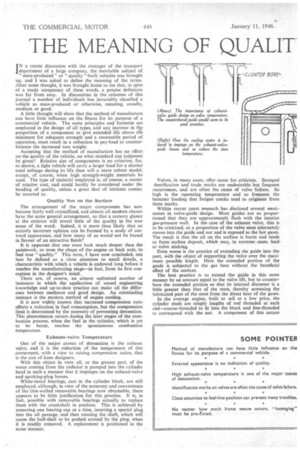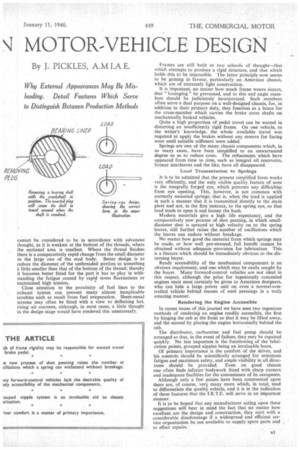THE MEANING OF QUALIT ■ I MOTOR-VEHICLE DESIGN
Page 30

Page 31

If you've noticed an error in this article please click here to report it so we can fix it.
IN a recent discussion with the manager of the transport department of a large company, the inevitable subject of " mass-produced " or "quality "-built vehicles was brought up, and I was asked to define the meaning of the terms. After some thought, it was brought home to me that, in spite of a ready acceptance of these words, a precise definition was far from easy. In discussions in the columns of this journal a number of individuals has invariably classified a vehicle as mass-produced or • otherwise, meaning, usually, medium or good.
A little thought will show that the method of manufacture can have little influence on the fitness for its purpose of a commercial vehicle. The same principles and formula2 are employed in the design of all types, and any increase in th.g proportion of a component to give extended life above ttte minimum for adequate strength and a reasonable period of operation, must result in a reduction in pay-load to counterbalance the increased tare weight.
Accepting that the method of manufacture has no effect on the quality of the vehicle, on what standard can judgment be given? Relative size of components is no criterion, for, as shown, a light vehicle will carry a larger load for a shorter total mileage during its life than will a more robust model, except, of course, when high strength-weight materials be used The type of material employed is, of course, a matter of relative cost, and could hardly be considered under the heading of quality, unless a great deal of intricate coatina be resorted to.
Quality Not on the Surface
The arrangement of the major components has max become fairly well crystallized, and almost all modern chassis have the same general arrangement, so that a cursory glance at the exterior will reveal little of the quality in the true sense of the word. Indeed, it is more than likely that an entirely incorrect opinion can be formed by a study of outward appearance, and how many of us would not be biased in favour of an attractive finish?
It is apparent that one must look much deeper than the paintwork: or even the shape of the engine or back axle, to find b-ue " quality." This term, I have now concluded, can best be defined as a close attention to small details, a characteristic with which a vehicle is endowed long before it reaches the manufacturing stage—in fact, from its first conception in the designer's mind.
There are, of course, an almost unlimited number of instances in which the application of sound engineering knowledge and up-to-date practice can make all the difference between mediocre and good design. An outstanding instance is the modern method of engine cooling.
It is now widely known that increased compression ratio effects a reduction in fuel consumption, but the compression limit is determined by the necessity of preventing detonation. This phenomenon occurs during the later stages of the combustion process. when the fuel in the cylinder, which is yet to be burnt, reaches the spontaneous combustion temperature.
Exhaust-valve Temperature One of the major causes of detonation is the exhaust valve, and it is the reduction of, the temperature of this component, with a view to raising compression ratios, that is the aim of keen designers.
With this object in view all, or the greater part, of the water coming from the radiator is pumped into the cylinder head in such a manner that it impinges on the exhaust-valve and sparking-plug bosses.
White-metal bearings, cast in the cylinder block, are still employed, although, in view of the economy and convenience of the thin-walled removable bearings now obtainable, there appears to be little justification for this practice. It is, in fact, possible with removable bearings actually to replace them with the crankshaft in position. This is achieved by removing one bearing cap at a time, inserting a special plug into the oil passage, and then rotating the shaft, which will cause the half-shell to be pushed around by the plug, when it is readily removed. A replacement is positioned in the same manner. Valves, in many cases, offer cause for criticism. Stamped dentification and trade marks are undesirable but frequent occurrences, and are often the cause of valve failure. So high is the operating temperature and so frequent the hammer loading that fatigue cracks tend to originate from these marks.
Within recent years research has disclosed several weaknesses in valve-guide design. Most guides are so proportioned that they are approximately flush with the interior gas-pressure wall. In the case of the exhaust valve, this is to be criticized, as a proportion of the valve stem alternately moves into the guide and out and is exposed to the hot gases. The result is that the oil on the surface is burnt and tends to form 'carbon deposit, MIMI may, in extreme cases, lead to valve sticking.
Even worse is the practice of extending the guide into the port, with the object of supporting the valve over the maximum possible length. Here the extended portion of the guide is subjected to the gas heat without the beneficial effect of the coolant.
The best practice is to extend the guide in this same manner by an amount equal to the valve lift, but to counterbore the extended portion so that its internal diameter is a little greater than that of the stem, thereby screening the lubricated part of the stem from the direct heat of the gases. In the average engine, built to sell at a low price, the cylinder studs are simply lengths of rod threaded at each end—coarse-threaded to fit into the block and fine-threaded to correspond with the nut. A component of this nature cannot be considered to be in accordance with advanced thought, as it is weakest at the bottom of the threads, where the sectional area is smallest. Where the thread finishes there is a comparatively rapid change from the small diameter to the large one of the stud body. Better design is to reduce the diameter of the unthreaded portion to something is little smaller than that of the bottom of the thread; thereby it becomes better fitted for the part it has to play in withstanding the fatigue caused by rapid stress fluctuations or maintained high tension.
Close attention to the proximity of fuel lines to the exhaust system can prevent many almost inexplicable troubles such as result from fuel evaporation. Sheet-metal screens may often be fitted with a view to deflecting hot, rising air currents, although, in most cases, a little thought in the design stage would have rendered this unnecessafy.
Frames are still built to two schools of thought—that which attempts to produce a rigid structure, and that which holds this to be impossible. The latter principle now seems to be gaining in favour, particularly on American chassis, which are of extremely light construction.
It is important, no matter how much frame weave occurs, that " lozenging " be prevented, and to this end angle members should be judiciously incorporated. Such members often serve a dual purpose on a well-designed chassis, for, in addition to their primary duty, they function as a brace for the cross-member which carries the brake cross shafts on mechanically braked vehicles.
Quite a high proportion of pedal travel can be wasted in distorting an insufficiently rigid frame. On one vehicle, to the writer's knowledge, the whole available travel was required to apply the brakes without any reserve for facing wear until suitable stiffeners were added.
Springs are one of the many chassis components which, in so many cases, have been simplified to an unwarranted degree so as to reduce costs. The refinements which have appeared from time to time, such as integral oil reservoirs, bronze interleaves and the like, have all disappeared,
Load Transmission to Springs • It is to be admitted that the present simplified form works very efficiently, and the only visible quality feature of note
• is the integrally forged eye, which prevents any difficulties from eye opening. This, however, is not common with correctly mounted springs; that is, when the load is applied in such a manner that it is transmitted directly to the main plate and not, in the first instance, to the spring eye, so that load tends to open it and loosen the bush.
Modern materials give a high life expectancy, and the comparatively new process of shot peening, in which smalldiameter shot is sprayed at high velocity on to the spring leaves, still further raises the number of oscillations which the leaves can endure without breakage.
No matter how good the material from which springs may be made, or how well pre-stressed, full benefit cannot be obtained without adequate provision for lubrication. This is a feature which should be immediately obvious to the discerning buyer.
Ready accessibility of the mechanical components is an obvious requirement, and one which may be easily sought by the buyer. Many forward-control vehicles are not ideal in this respect, although the prize for ingeniously, concealed engines must most certainly be given to American designers, who can hide a large power unit on even a normal-controlled vehicle behind masses of steel pressings in a truly amazing manner.
Rendering the Engine Accessible In recent issues of this journal we have seen two ingenious methods of rendering an engine readily accessible, the first by hinging the cab at the front so that it may be lifted away, and the second by placing the engine horizontally behind the cab.
The distributor, carburetter and fuel pump should be arranged so that, in the event of failure, they may be repaired quickly. No less important is the functioning of the lubrication points, grouped nipples being an invaluable boon.
Of primary importance is the comfort of the driver, and his controls should be scientifically arranged for minimum fatigue and maximum safety, and ample visibility in all directions should be provided Even on good chassis one often finds inferior bodywork fitted with sharp corners and inadequate facilities for the convenience of its occupants. Although only a few points have been commented upon there are, of course, very many more which, in total, tend to differentiate the quality vehicle, and it is in the indication of these features that the I.R.T.E. will serve in an important manner.
It is to be hoped that any manufacturer .acting upon these
suggestions will bear in mind the fact that no matter how excellent are the design and construction, they start with a considerable disadvantage if a widespread and efficient service organization be not available to supply spare parts and to effect repairs.




























































